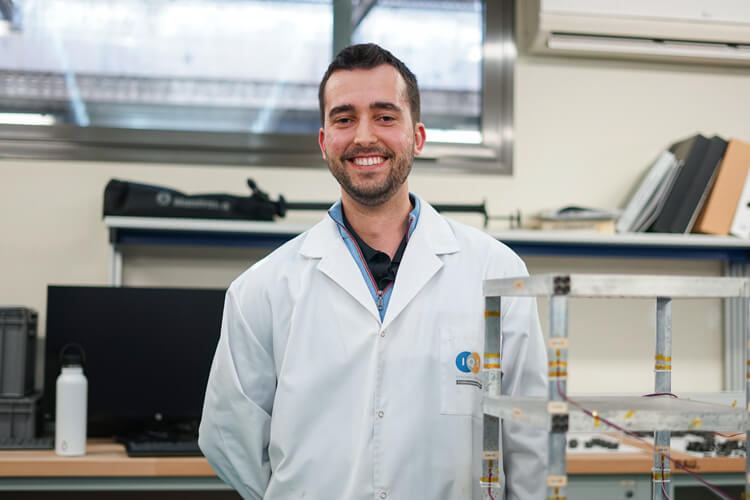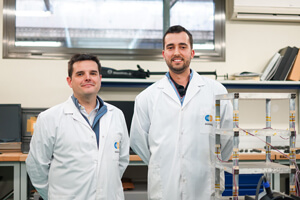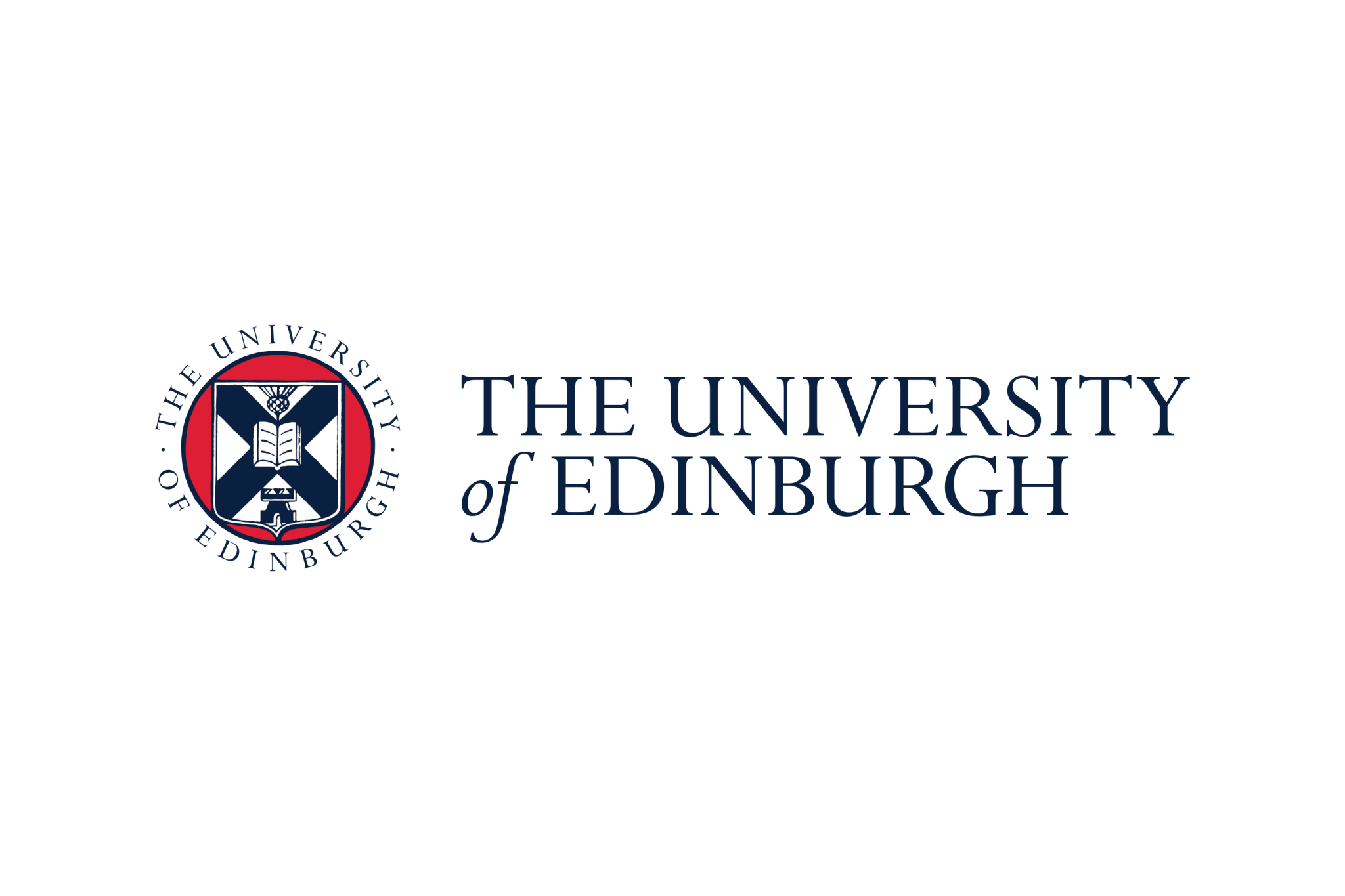Advanced Monitoring of the Health of Structures

In 2022, two member of the IQS community earned competitive University Professor Training grants (FPU grants), which are awarded by the Ministry of Universities within the framework of the State Scientific, Technical, and Innovation Research Plan (PEICTI) for 2021-2023.
Josep Font Moré, a doctoral student with the Industrial Engineering Department at the IQS School of Engineering, obtained one of the seven FPU grants awarded in the Civil Engineering category in the latest call for grants. Josep’s project addresses the “Detection of damage in structures using vibrations and artificial intelligence methods.” He is carrying out his work within the Applied Mechanics and Advanced Manufacturing Research Group (GAM), led by Dr Marco Antonio Pérez.
This research is focused on predictive maintenance for civil infrastructure using sensors to obtain information about the structures and ultimately to be able to know the integrity of the structures, in a manner similar to medical check-ups for patients. All the information will be processed using Machine Learning tools which will enable the researchers to find patterns and trends in complex data sequences.
Josep, what has earning this FPU grant meant to you?
For me it’s been really satisfying to earn it. I knew that it wouldn’t be easy and that I’d have to fight. They are highly demanding and competitive grants, where they assess many aspects: the candidate, the project, the director, and the research group. What’s more, the competition is nationwide. I’m very happy!
What is the goal of your project?
I started working with Dr Marco Antonio during my Final Degree Project on a research line that combined mechanical engineering, specifically vibrations, with statistical methods, with the goal of understanding the integrity of structures. The confluence of these disciplines in a project in the business world and its future application led me to opt for this proposal. Subsequently, during my Master Thesis, I continued working along this line of research, something that allowed me to start my doctoral thesis with a certain amount of prior knowledge.
My thesis is focused on the predictive maintenance of structures. By using different sensors, we can extract data that allow us to know the integrity of structures. The process is similar to ones used in medicine, like a blood analysis or an electrocardiogram. These are non-invasive tests that allow us to know about a person’s state of health. Here we’re following a similar process. We obtain information with non-invasive devices to determine whether or not a structure is “healthy.” A key piece in this entire process is the use of Machine Learning tools, which enable us to find patterns and trends in data series much more quickly.

What is an example of the application of this technology that you are developing?
The idea is to be able to predict possible problems, especially in structures that are vital for the area. For instance, the case of wind turbines is really interesting. Currently there’s a lot of interest in renewable energy sources like wind energy. However, selecting an appropriate area for wind, in other words for energy production, and being accepted by residents, makes it necessary to build these structures in isolated places. This makes maintenance more difficult and expensive. Additionally, current inspections require power generation to stop so the structure can be inspected by specialized personnel. In this sense, our research will help to implement automatic systems that are capable of acquiring and processing data through Machine Learning tools. Using these systems will improve the reliability of these structures and reduce the associated maintenance costs.
Although research from this field has garnered a lot of interest in recent years, challenges still remain that make it difficult to carry out the industrial implementation of these technologies and we had that in mind when defining the goals of the project. Now we’re working on mitigating environmental and operational effects. Temperature changes and wind, among others, are some of the dynamic phenomena that vary the response that we obtain from the sensors. This variability makes it more difficult to analyse, as they obscure the information that is extracted and generate greater uncertainty in the results.
Are you collaborating with another university or technology centre?
Yes. Currently we are collaborating with researchers from the University of Edinburgh and the University of Southern Denmark (SDU) to address this problem. Both universities have experience in monitoring wind turbines and their support has been a great complement for us and helped us move forward in this field.
As a result of this collaboration, I will be able to take advantage of the opportunity to spend three months at the SDU this year. Denmark is one of the leading countries in committing to wind energy and this university in particular is one of the benchmarks in monitoring techniques. This research stay will allow me to validate the methods that we are developing with data from real wind farms and delve deeper into the topic. This university’s relationships with companies from the sector is a great opportunity to enhance the project’s impact.
Marco Antonio, what do Josep’s contributions and the grant that he has earned represent for your group?
The FPU grant has been really satisfying for two reasons. First, because it will provide continuity to a line of research that will allow us to combine data from real structures with advanced Machine Learning techniques in order to extract and interpret patterns in collaboration with renowned international centres. But above all, because it’s possible to (temporarily) keep and nurture a talented young researcher like Josep, who is dedicated to science and is establishing a well-deserved international reputation.
Related publications
Josep Font, Guillermo Reyes, Ricard Lado, Marco A. Pérez, Performance analysis of vibration-based damage indicators under low-modal information structures, Mechanical Systems and Signal Processing 190(1):110166 (2023)
Ricard Lado, Josep Font, Marco A. Pérez, Learning-based video motion magnification approach for vibration-based damage detection,
Marco A. Pérez, Josep Font, Joan Fernàndez, Structural damage assessment in lattice towers based on a novel frequency domain-based correlation approach, Engineering Structures, 226 (2021), 111329.
This predoctoral contract has received funding from the Ministry of Universities for University Professor Training




